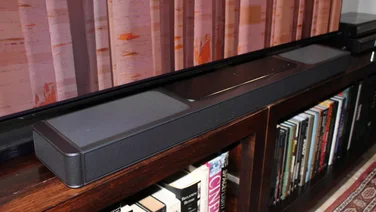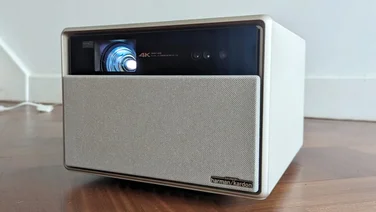To help us provide you with free impartial advice, we may earn a commission if you buy through links on our site. Learn more








- Bright images, crystal clarity and vivid colour
- Incredibly easy to setup and use
- Good audio turns great with optional speakers
- Prioritises clarity and detail over subtlety and nuance
- Satellite speakers need to charge from the projector
- No BBC iPlayer app
Anker’s new Nebula X1 projector may or may not be the best projector we review this year, but I’m doubtful we’ll see one that’s more innovative or ambitious. Not only has Anker designed a new laser-based optical engine and some rather ingenious mechanisms around it, but it’s rethought how a portable home cinema system might work.
While I have a few quibbles with the end result, this is still a hugely flexible and well thought-out package that might transform the way you watch movies, live events and your favourite shows in and around the home.
What do you get for the money?
The Nebula X1 itself is a large home cinema projector in Anker’s preferred vertical design, standing 246mm tall and with a 186 x 282mm (WxD) footprint. It looks a little like a super-sized version of the excellent Anker Cosmos 4K SE, and it has the 6.2kg weight to match. It’s built around a new U-shaped triple laser engine working with a six-blade f.2,0-4.5 iris and a 14-element zoom lens array.
That lens array is all glass, which is a rarity in affordable home cinema projectors. It gives you a throw ratio of 0.9 to 1.5:1, giving you an image of up to 200in in size from a 4m distance, or a 100in image if you have 2m to play with, which is a little more realistic in your average UK living room.








Nebula claims a maximum brightness of 3,500 ANSI lumens and a 5,000:1 native contrast ratio, while its NebulaMaster processing engine promises a wide colour gamut with professional grade colour accuracy and Dolby Vision HDR. All this has to be cooled by a custom-designed liquid cooling system which keeps noise levels down to a barely noticeable 26dBA. I could hear the X1 during testing, but not to the extent that it really registered while watching anything, even during quiet scenes.
The X1 owes its flexibility to a combination of hardware and software. On the one hand, the whole optical system is mounted on a motorised internal gimbal, which pivots up when you start the projector then scans up and down to find your screen. Anker then deploys its AI-powered Spatial Adaptation system to apply keystone correction, auto-focus and automatic obstacle avoidance, basically giving you the straightest and sharpest image possible from almost any sensible position.
Shift the projector slightly and it will do the auto-focus and keystone correction again, although I sometimes had to call in a full scan manually when moving the projector and screen to a different position or a different room. Cleverly, the system can recall previous settings if returned to a space it knows already.








On top of this you have built-in Google TV streaming, plus four side-firing internal speakers, with two 15W woofers and two 5W tweeters, along with two passive radiators for bass. But if you’re looking to take your sound up to a different level, you can also buy a £499 bundle featuring two wireless satellite speakers, plus two wireless microphones for karaoke, and a soft padded carry case for the whole shebang.
The satellites connect to the projector via Wi-Fi, and include two front drivers with a 40W amplifier, plus upward and side-firing drivers with an extra 20W of power. With the satellites connected, the onboard speakers focus on the low-end while the satellites handle more of the music, dialogue and surround effects. This radically transforms and improves the output.
While the X1 works stand alone for streaming, there’s scope to connect external sources such as a Blu-ray player or games console through the two HDMI 2.1 ports on the back, one of which supports eARC. There’s also a single USB-A port and a USB-C port, plus an S/PDIF optical output.
What does it do well?
For my money, Nebula and XGIMI are streets ahead of the competition when it comes to easy setup, and the X1 is another great example of why. You can set up Google TV with your smartphone within minutes, plonk the projector down in front of your screen, and basically let it handle zoom, focus and alignment. There are manual controls to tweak afterwards, but I barely needed to touch them. It all just works.
What’s more, the image quality is nearly always fantastic, with almost supernatural levels of clarity and detail. The X1 goes extremely bright – bright enough to be usable during daylight hours with some strategic curtain shutting – and colours are as rich and vivid as anyone could wish for.








I enjoyed working my way through my usual movie test scenes and TV shows on this projector, and it excelled with the sun-scorched scenery of Dune and the blockbuster action of Avengers: Endgame. It didn’t fall down with the firelit interiors of The Northman or the subtle tones of Shogun. HDR-heavy games and action movies dazzle, just as they should.
Yet I also found myself – and my family – watching lots of ordinary TV, from nature and travel shows to modern prestige dramas. There’s something about the scale and detail that makes you feel like you’re almost there.
Colour reproduction is extremely good for a projector, though I did spend a little time fiddling with the picture modes and settings to get the best results. On the Standard setting, I could get 96.6% sRGB coverage with a 129.8% gamut volume and 88.8% of DCI-P3 with a 92% gamut volume. I’m pretty confident I could get even better results with some more tweaking and a high-end screen.








But what really sets the X1 apart from, say, the XGIMI Horizon S Pro for me is the audio. THe output from the built-in speakers is already pretty good. It’s not too directional, dialogue comes through clearly and there’s some nice steering of surround audio effects. But bring in the wireless satellites, pull out their supports and turn them on and the sound takes on a new dimension.
Music gains body and sounds more powerful, while dialogue and effects cover a much wider and deeper soundstage. It’s all just more immersive, which is exactly what you want from a home cinema system. It’s not in the same league as a proper home cinema audio separates system, but it can definitely give smaller soundbars a run for their money.
What could it do better?
My biggest complaint with the X1 is that it sometimes goes too far in pursuit of contrast, clarity and vivid colours. This really suits some material, but I found that with older movies or more gritty, atmospheric movies, there was almost too much resolution and depth, making scenes look artificial in a way that pulled you out of the experience.
This is very much a subjective thing, and I was able to counter it by turning down motion compensation and switching from the default NebulaMaster picture mode to the Cinema setting, then tweaking a few colour settings here and there. Yet there were times when I preferred the presentation of the BenQ W2720i, even though the X1 beats it on colour accuracy, clarity and detail.








I also found it slightly annoying that the satellite speakers wouldn’t charge from a standard 65W USB-C charger, but for some reason needed to be charged from the projector itself using the USB-C to USB-C cable provided. It’s not a big deal – they only take around two hours to charge and a charge lasts for roughly 14 to 16 hours depending on the volume level.
You should also bear in mind that while the Nebula X1 is vaguely portable, it still needs a mains power source. There’s no internal battery and it’s too power hungry to run off a USB power bank. Finally, while the Google TV implementation works well and incorporates most of UK catch-up TV services and streaming apps, BBC iPlayer is notable for its absence. If you want BBC drama, sports and events on the big screen, you’ll need to plug in a streaming stick.
Nebula X1: Should you buy one?
Where most previous Nebula projectors have undercut the competition on price, the X1 is reasonably expensive and the speakers and case bundle is a significant investment. What’s more, serious home cinema buffs may prefer a more conventional unit that focuses entirely on making movies look their best.
Yet, I also think that there are going to be some people out there who have been waiting for a product just like this. Not only does it deliver great picture quality, but – bundled with the satellite speakers – cracking sound. You can set it up quickly, pump up the volume and have a great time with your favourite shows and movies.
Even without the speakers, it’s a solid buy, delivering similar or slightly better image quality to the XGIMI Horizon S Pro and Horizon S Max, but with higher brightness levels and more powerful sound. Is there room for improvement? Here and there, but the X1 puts Nebula right up there with the best compact home cinema projectors you can buy. Stretch to the speaker bundle if you can, and you have everything you need for an incredible night in.







